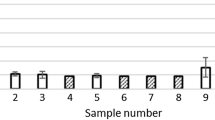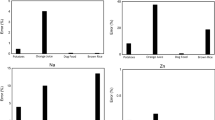Abstract
Kohl is a widely used traditional cosmetic. It is mainly worn around the eyes in the Middle East, Asia and Africa. The elemental composition of twenty-one kohl specimens originating from various parts of Saudi Arabia, India and the Middle East was determined by energy dispersive X-ray analysis (EDAX). The data indicates the presence of significant lead levels in two thirds (14/21) of the kohl specimens ranging from 2.9–100 (mean 48.5). Other less frequent elements present in kohl preparations include aluminum, carbon, iron, titanium, calcium, magnesium, oxygen, silver silicon, sulfur and antimony. Seven kohl specimens were totally lead-free, four had a lead content in the range of 2.9–34.1 and ten had lead levels in excess of 84. Carbon levels in excess of 60 were detected in six kohl samples. Antimony was present in only one kohl specimen at a concentration of 7.8.
Five western made eyeliner pencils analyzed for comparative purposes consistently revealed iron as a common constituent (mean 46) but no lead or carbon were detected in these specimens.
The findings of this study indicate that modern kohl preparations contain a number of metals derived from natural sources in addition to carbon. The predominance of lead in the kohl preparations tested is of major concern due to the documented adverse effects in humans and the increased susceptibility of children to lead intoxication. Application of lead-containing kohl needs to be considered as a source of lead in evaluating patients with symptoms of lead intoxication in regions where this tradition prevails. The documented toxic effects of lead in humans and the increased sensitivity of children to lead exposure serve to emphasize potential health risks of using traditional lead containing kohl preparations and the need for increased surveillance and regulation of the manufacture of kohl.
Similar content being viewed by others
References
Al-Hawi SA. Kohl. In: Wafai MZ, Kalaagi MR (eds) Al-Ugun WA, Jame Al-Funun. Light of the Eyes and the Collector of Arts. King Faisal Center for Research and Islamic Studies, Riyadh, Saudi Arabia 1980; 1286: 142–8.
Al-Jawazi BAQ. Islamic Medicine. Revised and corrected by Abdulghani Abdulkhaleg, Cairo, p 218, 1957.
Al-Kawajah AM. Al kohl use in Saudi Arabia: Extent and possible lead toxicity. Trop Geograph Med 1992; 44 (4): 373–7.
Nir A, Tamir A, Zelmik A, Iancu TC. Is eye cosmetic a source of lead poisoning? Israel J Med Sci 1992; 28 (7): 417–21.
Yaish HN, Niazi G, Al-Soby A. Lead poisoning among Saudi children. Ann Saudi Med 1993; 3 (5): 395–401.
Oxford English Dictionary. Kohl. Oxford University Press, Oxford, England, p 152, 1989.
Fernando NF, Healy MA, Aslam M. Lead poisoning and traditional practices - the consequences for world health: a study in Kuwait. Public Health (London) 1981; 95: 250–60.
Warley MA, Blackledge P, O'Gorman P. Lead poisoning from eye cosmetic. Brit Med J 1968; 1 (584): 117.
Aulfat RA, Smales ORC, Aslam M. Surma and lead poisoning. Brit Med J 1978; 2: 915–6.
Chan H, Yan Yeh Y, Billimeir J, et al. Lead poisoning from ingestion of Chinese herbal medicine. Clin Toxicol 1977; 10: 273–81.
Shaltout A, Yaish SA, Fernando N. Lead poisoning encephalopathy in infants in Kuwait. Ann Trop Pediatr 1981; 1: 209–15.
Abdulla MA. Lead poisoning among children in Saudi Arabia. Ann Trop Pediatr 1984; 87: 67–70.
Rahman H, Al-Khayat A, Menon N. Lead poisoning in infancy: Unusual cases in the UAE. Ann Trop Pediatr 1986; 6: 213–7.
McGraw-Hill Encyclopedia of Science and Technology: Antimony. McGraw-Hill Book Company, New York 1987: 646–8.
Tabbara KF, Burd EM. Microbial content of kohl. Ann Saudi Med 1987; 7 (3): 177–9.
Parry C, Eaton J. Kohl: A lead hazardous eye make-up from the third world. Env Health Persp 1991; 94: 121–3.
Al-Kaf A, Al Rajhi A, Tabbara K, El Yazigi A. Kohl — The traditional eyeliner: Use and analysis. Ann Saudi Med 1993; 13: 26–30.
Al-Saleh IA, Fellows C, Delves T, Taylor A. Identification of sources of lead exposure among children in Arrar, Saudi Arabia. Ann Clin Biochem 1993; 30: 142–5.
Nriagu JO, Lead and head poisoning in antiquity. John Wiley & Sons, Toronto, 1983.
Winship KA. Toxicity of antimony and its compounds. Adverse Drug Reactions & Acute Poisoning Reviews 1987; 62 (2): 67–90.
Snodgrass GJ, Ziderman DA, Gulati V, Richards J. Letter: Cosmetic plumbism. Br Med J 1973; 4 (886): 230.
Betts PR, Astley R, Raine DN. Lead intoxication in children in Birmingham. Br Med J 1973; 1 (850): 402–6.
Ali AR, Snales ORC, Aslam M. Surma and lead poisoning. Br Med J 1978; 2: 915–6.
Author information
Authors and Affiliations
Additional information
The opinions or assertions contained herein are the private views of the author and are not to be construed as official or as reflecting the views of the Department of the Army or Department of Defense.




